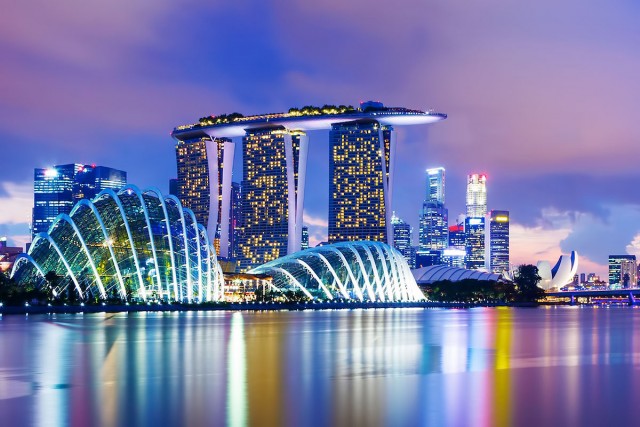Singapore
Area 430.4 square mi (692.7 square km)
Population 5.470 million 2014
Capital Singapore
Highest Point 545 ft (166 m)
Lowest Point 0 m
GDP $307.9 billion 2014
Primary Natural Resources rubber, copra, fruit, vegetables, orchids, poultry.
THE REPUBLIC OF Singapore consists of a main island and a group of 58 islets. It is situated in Southeast Asia, only 85 mi (136.8 km) north of the equator. The diamond-shaped main island, accounting for 90 percent of country's area, is connected by a causeway with MALAYSIA and mainland Asia. During World War II, the Japanese surprised the British by invading Singapore by land using this causeway. For four years, until 1945, Singapore was occupied by JAPAN. Singapore was founded as a British colony in 1819 for trading purposes.

Its highest point is at the central part of the main island, though it is mainly a low-lying island country not much above sea level. Singapore is a country with an equatorial climate and with 96 in (240 cm) of annual rainfall; no month receives less than 6 in (10 cm). The temperature remains uniform year-round, the mean daily being 75 degrees F (23 degrees C).
Its population of 4.6 million (2003) has an equitable male/female ratio; a low birth rate (-12.75 per 1,000); and a fertility rate of 1.24, indicating a negative natural growth through a high net migration rate of 26 per 1,000, which caused a significant positive growth in 2003. Singapore is ethnically diverse, with 78 percent Chinese (Buddhist), 14 percent Malays (Muslim), and 7 percent Indians (mainly Hindu). Ethnic and religious harmony has been maintained. Singapore was a British colony until 1963, when it was joined into a federation with Malaysia.
In 1965, it seceded from the latter and became an independent country. It introduced parliamentary democracy. Since 1965, the Peoples Action Party (PAP) has dominated the parliament resulting from democratic elections that take place every five years. The last parliamentary election was held in 2001; Chok Tong, first elected as prime minister in 1990, was elected for the third term. The PAP has introduced an innovative economic policy of egalitarianism offering a Fabianstyle socialist system guaranteeing a minimum economic level to everyone.
Singapore's healthy free market economy, corruption-free society, and stable democracy make it an attractive investment haven in Asia. The state-sponsored Housing Planning Board houses 9 out of every 10 in the country mainly in modern apartments in high-rise complexes. Singapore has turned from a developing country in the 1960s (the per capita gross domestic product [GDP] in 1960 being $280) to a developed country with a per capita GDP of $20,733 in 2003.
Taking advantage of its crossroads location between the INDIAN and PACIFIC oceans, it has turned into the world's busiest container port and one of the busiest world ports in tonnage. It is a manufacturing center for electronics and metal products, chemicals, petroleum refining, and transport equipment. Being a city-state, agriculture is not important. Apart from machinery and equipment, mineral fuel and chemicals, it imports almost all the required foodstuffs. Singapore is also a notable financial and economic center. It has had a thriving stock market since the 1970s and is on its way to becoming Southeast Asia's hub for financial and high-tech activities. Singapore's downtown has been converted into a modern skyscraper city. The three most impressive skyscrapers are by the side of the Singapore River—Overseas Union Bank, United Overseas Bank and Overseas Chinese Banking Corporation. Since the end of 1980s, it has introduced an underground metro or subway system.